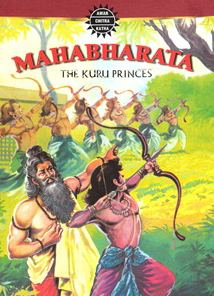Genre Mythology Number of issues 42 | Publication date 1985 - 89 | |
 | ||
Schedule Alternative Title Schedule | ||
Mahabharata (also known as Amar Chitra Katha's Mahabharata) is a comic adaptation of Indian epic poem Mahabharata. The 42-issue best-selling series by Amar Chitra Katha, Mumbai was illustrated by Dilip Kadam. The team of script writers (took turns to complete the 42 issues) included Kamala Chandrakanth, TMP Nedungadi, Subba Rao, Yagya Sharma, Lopamudra, Mihir Lal Mitra, Sumona Roy, Mohan Swaminathan, Shubha Kandhekar and Margie Sastry.
Contents
The Mahabharata is often regarded as one of the most popular title in the history of Amar Chitra Katha. It is also the longest series (42 issue run on an alternative title schedule; from 329-441 [1985-89] in over more than 1300 pages) to have been produced by the ACK. The series was originally planned for 60 albums, but it was later cut short to 42.
Concept and creation
Amar Chitra Katha had a strong commitment to the Mahabharata from the very beginning. Many of its titles were from based on particular events or characters from the Mahabharata. In March 1985, the new project began, "in response to a persistent demand from our readers for a comprehensive account of the epic." The ambitious series by Anant Pai was initially decided as a 60 volume project, with one issue in every fortnight. However, in 1988, Amar Chitra Katha issued only one issue a month, so that Mahabharata numbers came out only in every two months.
The Mahabharata comics was based on,
Structure
The comics does not include the Harivamsha (a supplement to the Mahabharata), the romance of Damayanti, the legend of Savitri and the abbreviated version of the Ramayana. It also omits the character Ugrasrava Sauti and the first issue ("Veda Vyasa") begins with sage Vyasa acquiring the elephant god Ganesha as his scribe and starting the dictation. It soon moves on to Vaisampayana narrating the epic to Janamejaya. This latter pair persist till the last panel of the series, appearing from time to time in panels colored differently.
The comics also included various footnotes explaining the meaning Sanskrit terms, and the few issues also consisted a pronunciation guide and glossary. Issues usually start with a page containing a summary of the last few issues, and in the backdrop illustrations of the Gita setting, with Arjuna kneeling before Krishna in the battlefield.
Influences and conflicts
Amar Chitra Katha series on Mahabarata (1985–89) coincided with Baldev Raj Chopra's famous television drama series Mahabharat (1988–90). Although, some fans took great pleasure in encountering Mahabharata in both mediums, the television series spelled big trouble for the comic book series. Amar Chitra Katha and the state-run Doordarshan television channel (DD National) competed for the same urban middle class audience.
It is widely accepted that visual and narrative "homogenization" occurs between the ACK'S Mahabharata and Baldev Raj Chopra's Mahabharat. Television producers have repeatedly turned to the Amar Chitra Katha series as reference material for costume design, set production, and subject matter.
"When the Mahabharat television series was made, I had friend who was a cameraman at the set. And he told me that they often brought the ACK Mahabharata series onto the set and used it as reference material-for dress, the building, and also for the episodes, the content. It is Kamala Chandrakant who deserves credit for this. She was thorough and very, very careful with regards to authenticity."
The advertisements of the comic series contained the exhortation "Read it to enjoy your Sunday viewing [of the BR Chopra's Mahabharat]!". It seems possible that the comic series was hastened to 42 issues from 60 to take advantage of the television series.
